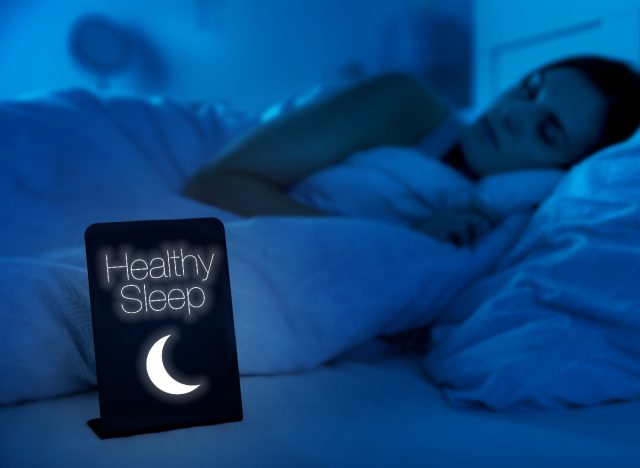5 Science-Backed Ways to Get a Lean & Toned Physique – When you want to get lean and toned, it’s always a smart idea to consider tried and true methods that are backed by science. We all know that following a strict diet isn’t for everyone, and the same goes for spending all of your free time at the gym lifting weights and taking fitness classes. Achieving your end goal will of course take hard work, dedication, and a combination of healthy habits—but it doesn’t have to feel like a total chore. Trends come and go, but scientifically proven ways to get into shape are here to stay. We did the digging for you and rounded up some of the best science-backed ways to get lean and toned, so listen up and gear up to sculpt your ideal physique.
Keep reading to learn more about the below science-backed strategies to get lean and toned, and when you’re finished, be sure to check out People Who Lost 10 Pounds in a Month Reveal Their 4 Best Workout Habits.

Ditching ultra-processed foods for plenty of whole foods (or opting for plant-based altogether) is the name of the game. Science says it’s an excellent way to lose weight and reveal your dream body.
According to 2020 research published in the American Journal of Lifestyle Medicine, there are a few things that have an impact on how effective different weight loss diets or eating habits are, and they include protein sources, calorie density, and water content. The research also explains that a plant-based diet can be a productive way to treat and even reverse chronic health conditions and “killers” such as high blood pressure and type 2 diabetes. In addition, eating lots of plant-based items “appears to be the most effective diet for weight loss,” the research says.
As if you needed more convincing, another study in Cell Metabolism revealed that nixing ultra-processed foods from your lifestyle lowers energy intake and helps you lose weight, compared to consuming a diet filled with ultra-processed foods, which results in unwanted weight gain. Individuals in the study followed an ultra-processed diet and ended up eating around 500 extra calories daily. When eliminating these foods, they shed weight.

After your 30th birthday, you can lose anywhere from three to five percent of lean muscle each decade. That’s why it’s imperative to perform muscle-strengthening activities, even if you want to lose weight. It may sound counterintuitive to grow your muscles when you want the number on the scale to move down, but weight lifting or strength training is an excellent way to achieve your weight loss goals and help you build up your supply of lean muscle.
A 2021 systematic review and meta-analysis from the University of New South Wales published in Sports Medicine looked over existing research and suggested you can trim around 1.4% of your overall body fat by just strength training. This is comparable to how much you could lose when performing aerobic exercise or cardio.
Senior author of the study Dr. Mandy Hagstrom, exercise physiologist and senior lecturer at UNSW Medicine & Health, explained, “A lot of people think that if you want to lose weight, you need to go out and run. But our findings show that even when strength training is done on its own, it still causes a favorable loss of body fat without having to consciously diet or go running.”

Engaging in high-intensity interval training (HIIT) will get you lean and toned at the same time—and research backs this up. HIIT involves performing short bursts of high-intensity exercise, moving from one move into the next, with little breaks to rest. Build up your muscle tone and soak up the benefits of the cardio component by adding HIIT to your current routine.
According to research published in the Journal of Physiology, “low volume” HIIT consists of doing less than 15 minutes of exercise at a high intensity per workout. Performing this kind of exercise in just four minutes, three times a week, for a total of 12 weeks, can improve fat in the liver, blood sugar levels, and cardiorespiratory fitness in adults who have type 2 diabetes. More research on high-intensity exercise associates it with a modest decrease in subcutaneous and abdominal fat, along with a substantial increase in aerobic and anaerobic fitness.

Not getting enough sleep can wreak havoc on your health in more ways than one. According to research published in the Annals of Internal Medicine, not getting sufficient, solid sleep could support the retention of body fat and derail your weight loss efforts. In addition, late-night eating or eating a big meal right before bed can not only disrupt your sleep, but research shows that it can result in packing on unwanted pounds.
There are certain tweaks you can make in your diet and bedtime routine in order to promote a restful night’s snooze. For instance, eating a well-balanced breakfast, putting a limit on any nighttime alcohol consumption, filling up your body with enough calories during the day, including fiber in your diet, powering down electronics well before bed, and sleeping in a cold, dark room can all have a positive impact on your sleep.

If your hobbies and workouts aren’t giving you some sort of joy, it’s time to reevaluate. Of course, strength training and cardio are essential in your weight loss efforts and leading an all-around healthy life, but finding happiness in the physical activity you do should not be overlooked.
Research suggests that getting involved in exercise and physical activity can present positive effects on individuals dealing with depression that are comparable to following antidepressant treatments. Depression has been linked to weight gain (and vice versa), so finding ways to deal with depression through exercise can be a productive way to alleviate symptoms and help you lose weight in the process. Plus, when you’re happy, the amount of dopamine in your body skyrockets, which is another beneficial contributor to weight loss. So head outdoors for a rejuvenating hike, go to the lake for an afternoon of kayaking, get involved in pickleball or tennis, or stretch it out with some yoga.








